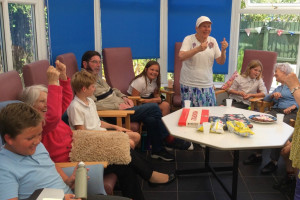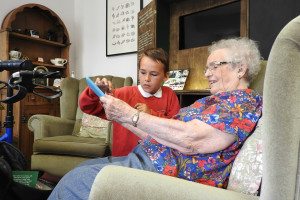Blog
Is there a tendency to privilege one generation in IG activities?

In August this year we posted a very upbeat news item on the TOY facebook about a Channel 4 documentary called Old People’s Home for 4 Year Olds.
In response to the same documentary Hannah Rumble from the University of Bristol asks the important question if there is a tendency to privilege one generation over another in intergenerational initiatives involving children and older adults. Read Hannah’s blog below.
Over the last couple of weeks Channel 4 have aired a documentary programme on British television called Old People’s Home for 4 Year Olds, which follows a nursery group who share their classroom with 11 older adults living in a ‘retirement home’ in Bristol for six weeks. The documentary programme focuses on social isolation in older adults living in care and tracks these older adults over the period of making the programme to see if their physical and psycho-social health improves when they share their days with nursery-school aged children and are made to interact with them in various organised activities from story-telling, to games and taking walks together. Perhaps inevitably, the programme is emotive with many heart-warming comments from the adult participants in the care home such as: “It’s nearly impossible not to be affected by the joy of the children”, “I suddenly felt wanted and it felt very nice”, participation in the programme “has drawn me out of my semi-sleep” and “being with these kids is like having a shot of adrenaline”! However, whilst the adult participants and programme makers, as well as academics like myself working on similar non-medical, intergenerational interventions in care settings, will argue they benefit older adults in care socially, emotionally, physically and psychologically, what can we say about the benefit to the “affectionate, lively, lovely, little children” as one older resident described them in the television programme?

I am concerned that it is usually one generation privileged over another in these intergenerational activities, be it the school-age children or the older adults in care. Having observed many intergenerational interventions in care settings for research purposes, it has become clear that it is very difficult to deliver activities that are both appealing and beneficial to the older adults and school pupils simultaneously. We need to be mindful of this when making claims about the benefits of intergenerational activities, as there is a tendency for the school pupils or pre-school children to be used as ‘entertainment’ for older adults living in care, or vice versa; for older adults to be used for some psycho-social or pedagogical benefit to the young participants. We need to be honest with ourselves about what we are doing when designing and delivering intergenerational interventions and be mindful that teachers and care staff may privilege one group in the intervention over another. I am not saying that this is ‘wrong’ and therefore, morally suspect to design and deliver intergenerational initiatives – far from it – just that we need to be more honest in the claims we make about who benefits from intergenerational activities and how.
Parlours of Wonder is a collaborative initiative between academics at the University of Bristol, care providers (Brunel Care, Hanover Housing and Mears Care), digital designers and a charity that offers intergenerational activities in care settings. It was funded for one year by the Arts and Humanities Research Council, in order to co-design engaging community focused spaces (‘Parlours’) within three care settings located in South West England to be used for intergenerational encounters across institutional boundaries for co- learning, discovery, sharing and play, whilst aiming to be meaningful to all, both ‘young’ and ‘old’ and challenge their respective social isolation.

What sets the successful television programme apart from our initiative, which we’ve been delivering within the same city at neighbouring care homes since November 2016, is that in the television programme all the adult participants appear to be cognitively able, even if they are lacking physical capabilities such as sight, hearing or mobility. In contrast, those older adults we have been working alongside in our intergenerational activities very often live with dementia, which immediately presents challenges for the scope and format of the intergenerational activities one can deliver in care settings. So ultimately, whilst one older participant in a Parlour of Wonder told me that “age is no barrier” to meaningful participation in intergenerational encounters, I would argue that (sadly) cognitive ability is and that the benefits of such encounters are not equally felt across the generations taking part. A first step might be for those of us involved in advocating and/or delivering intergenerational projects to consider who is rendered invisible and voiceless through their non-participation and review how hierarchies of ability are reinforced or naturalised in an intergenerational activity.
We would be delighted to hear your views and experiences on the issues discussed in this blog.
You can contact Dr Hannah Rumble directly at the School of Education, University of Bristol, email: h.rumble@bristol.ac.uk
You can also contact Margaret Kernan, the TOY blog editor, email: margaret@icdi.nl